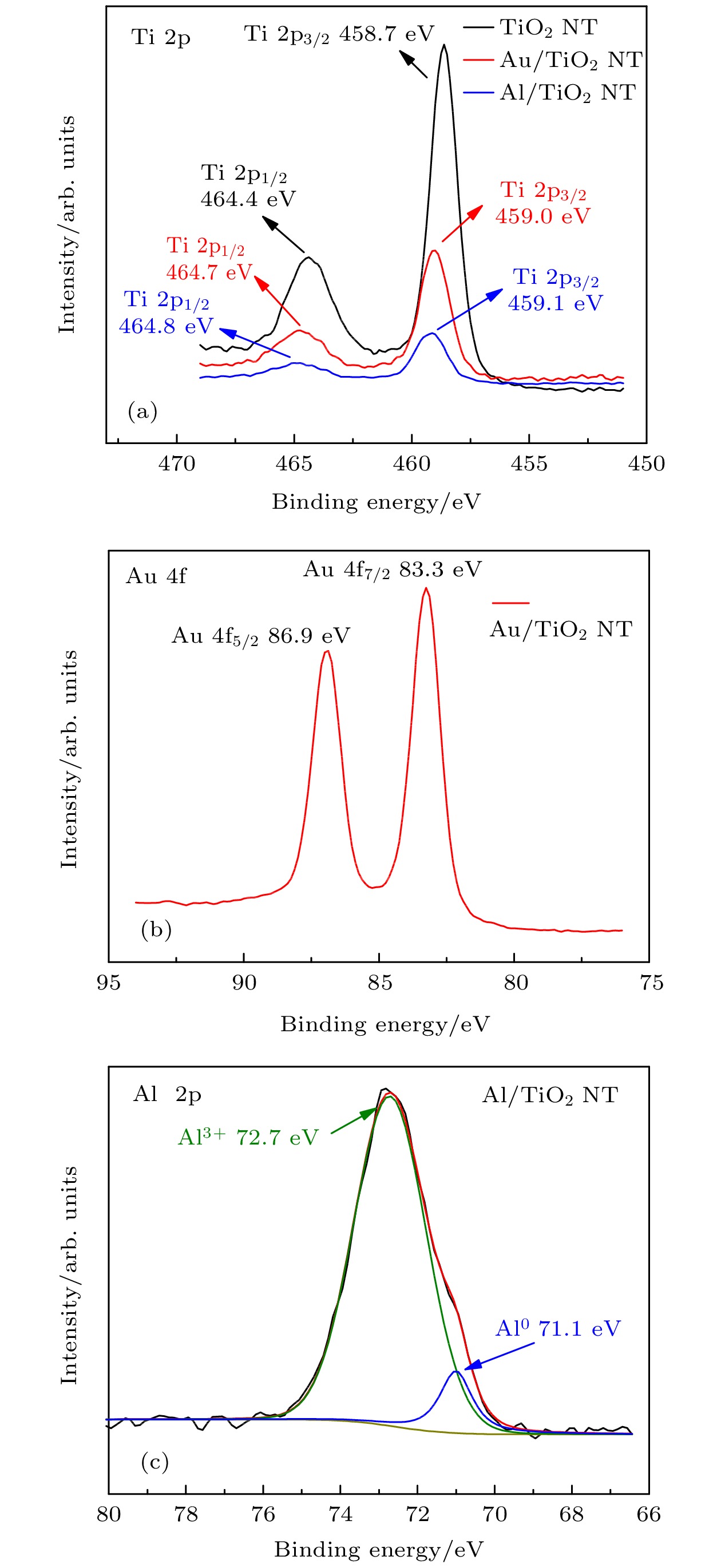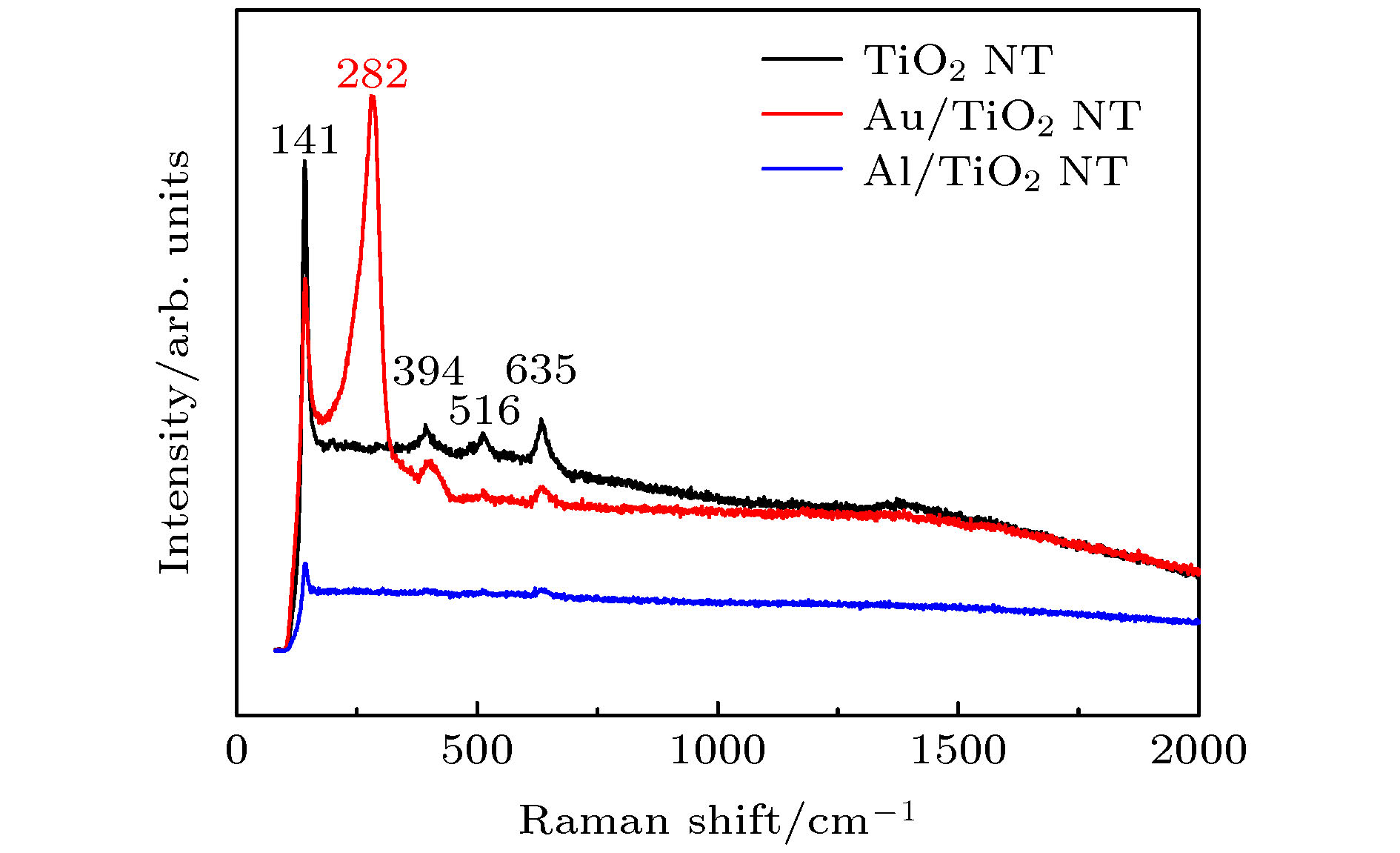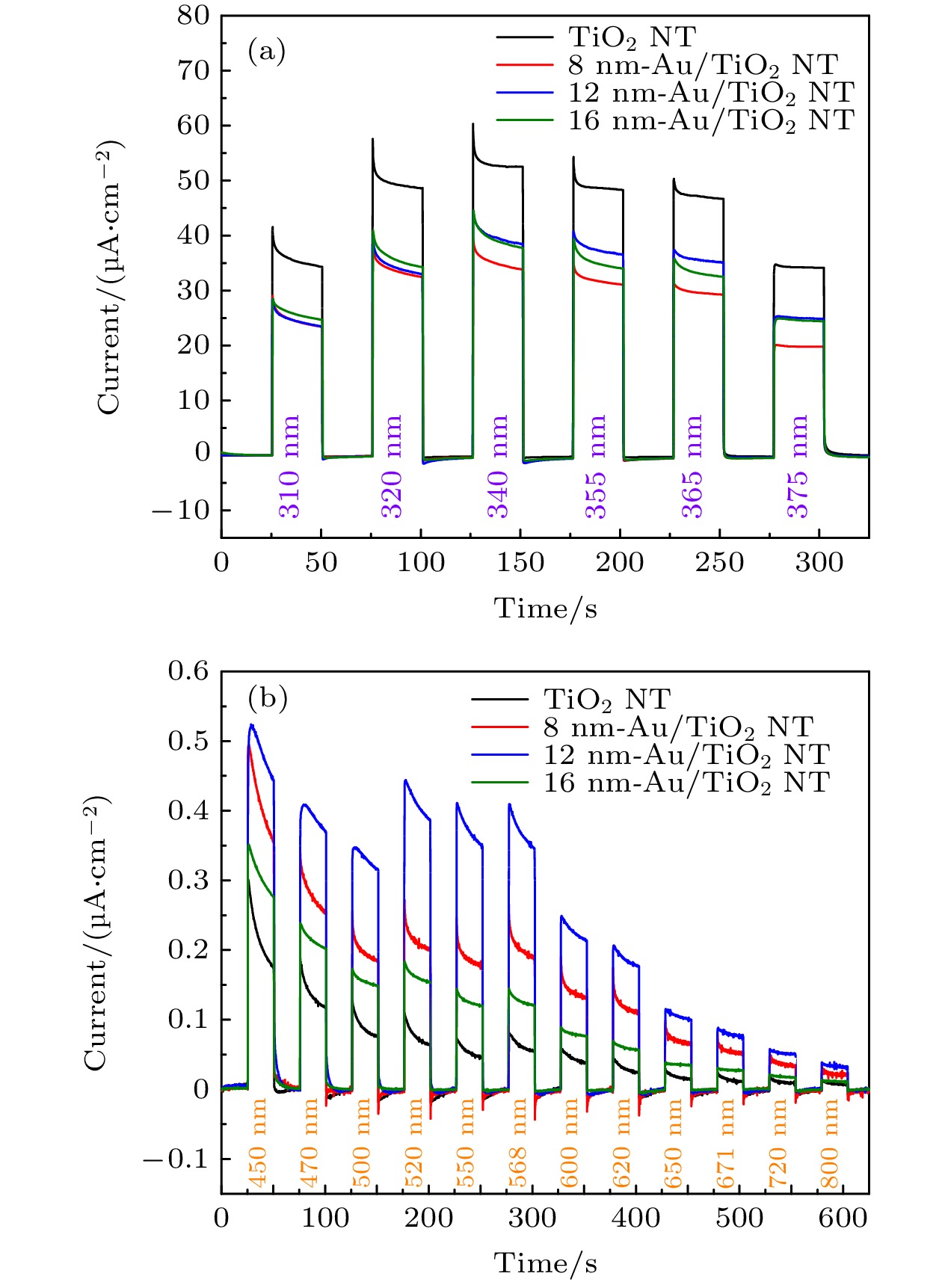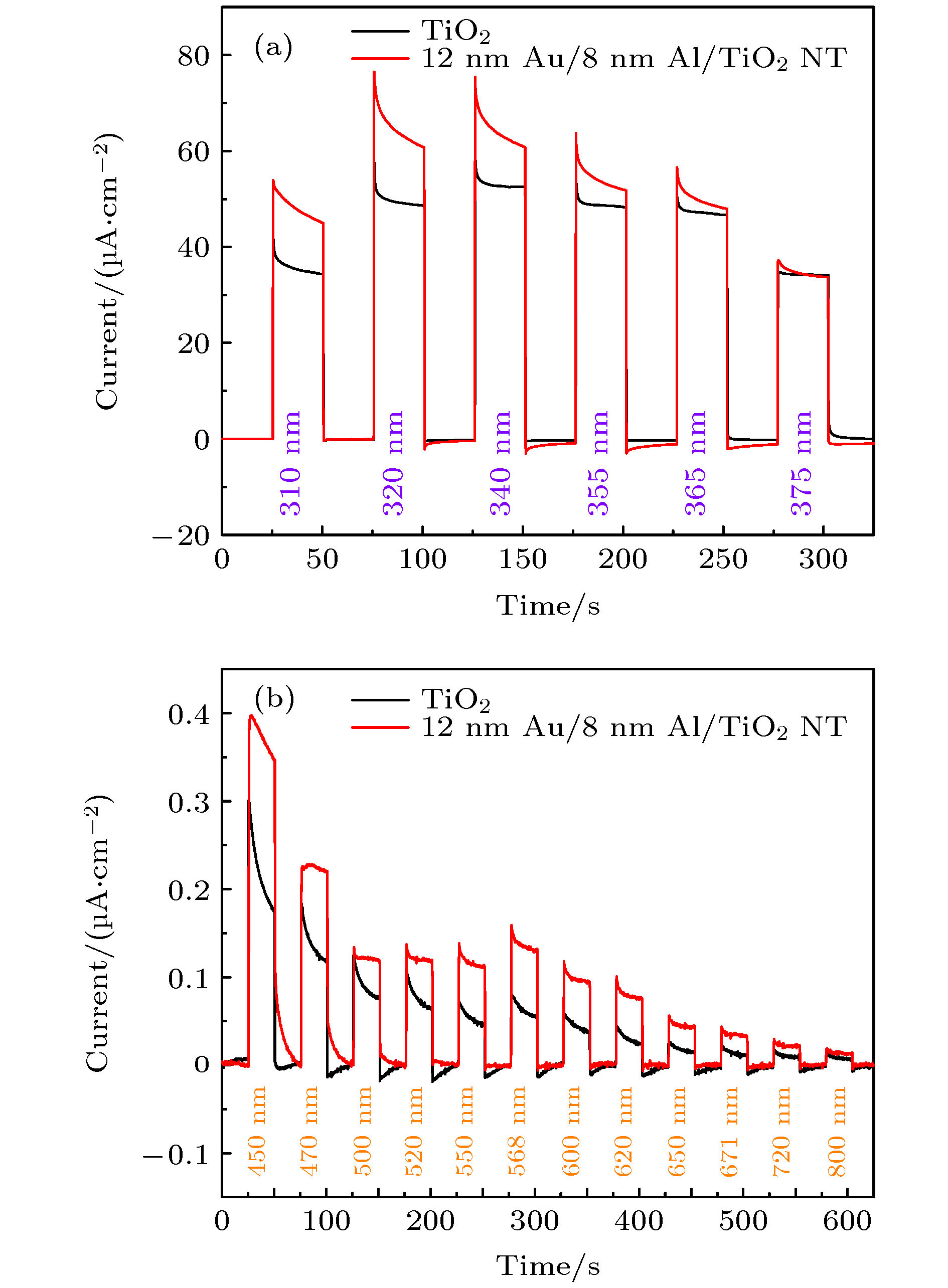-
将传统半导体材料与金属微纳结构相结合, 利用其表面等离激元共振效应, 可有效地增强复合结构的光电转换效率, 使其广泛地被用于光电化学和光电探测等领域. 本文以氧化铝纳米管为模板, 采用原子层沉积技术制备出高有序的TiO2纳米管, 并通过电子束热蒸发技术在大孔径的纳米管薄膜中分别负载金、铝和双金属金/铝纳米颗粒, 形成金属纳米颗粒/TiO2纳米管复合结构. 研究结果表明, 相对于纯TiO2纳米管, Au/TiO2复合纳米管在568 nm的可见光照射下, 其光电流密度约有400%的提高; 在365 nm紫外光照射下, Al/TiO2复合纳米管的光电流提高约50%; 同时负载双金属Au和Al纳米颗粒的TiO2纳米管在整个紫外-可见光区域光电流均显著增强.In recent years, due to the shortage of fossil energy and environmental pollution, the harvesting and conversion of solar energy using semiconductors has attracted more and more attention. Among many kinds of traditional semiconductor photocatalysts, the titanium dioxide (TiO2) has become one of the most popular semiconductor photocatalysts because of its low cost, good stability and environmental friendliness. However, TiO2 has a relatively wide band gap (i.e., 3.2 eV for anatase and 3.0 eV for rutile), which can only absorb ultraviolet light with a wavelength less than 387 nm, and has a low utilization rate of sunlight. Moreover, the photo-generated electron-hole pairs in the system of TiO2 film and particle are easy to recombine, which makes the photocatalytic efficiency of the material relatively low. In order to solve these problems, TiO2 structure with porous (such as nanotube) is used to restrain the recombination of photo-generated electron-hole pairs due to its large specific surface area and good charge transfer characteristics, thereby improving its photocatalytic efficiency. In addition to changing the structure of traditional semiconductor materials, using the surface plasmon resonance effect of metal micro-nano structures to improve its photoelectric conversion efficiency has many potential applications in the fields of photovoltaic, photocatalysis and photoelectric detection. In this paper, we prepare different metallic nanoparticles loaded TiO2 nanotube composite structures by atomic layer deposition method and electron beam thermal evaporation technology and investigate the photocatalytic properties of the composite structures. It is shown that comparing with the pure TiO2 nanotubes, the photocurrent of TiO2 nanotubes loaded with Au nanoparticles increases by about 400% under 568 nm visible light irradiation; the photocurrent of TiO2 nanotubes loaded with Al nanoparticles increases by about 50% under 365 nm ultraviolet (UV) irradiation; the photocurrent of TiO2 nanotubes loaded with bimetallic Au and Al nanoparticles increases by about 50% in the whole UV-visible light region: it is significantly enhanced. Based on the fact that the surface plasmon resonance frequency of Au and Al nanoparticles are complementary, not only is the optical absorption of TiO2 nanotubes enhanced and broadened, but also the photocurrent is enhanced from ultraviolet to visible light. We believe that these results will contribute to the further development of photocurrent in semiconductor nanotubes.
-
Keywords:
- nanotube /
- surface plasmon /
- metallic nanoparticles /
- photocurrent
[1] Fujishima A, Honda K 1972 Nature 238 37
 Google Scholar
Google Scholar
[2] Archer M D 1975 J. App. Electrochem. 5 17
 Google Scholar
Google Scholar
[3] Takata T, Tanaka A, Hara M, Kondo J N, Domen K 1998 Catal. Today 44 17
 Google Scholar
Google Scholar
[4] Khaselev O, Turner J A 1998 Science 280 425
 Google Scholar
Google Scholar
[5] Kudo A, Miseki Y 2009 Chem. Soc. Rev. 38 253
 Google Scholar
Google Scholar
[6] Parida K M, Martha S, Das D P, Biswal N 2010 J. Mater. Chem. 20 7144
 Google Scholar
Google Scholar
[7] Biswal N, Das D P, Martha S, Parida K M 2011 Int. J. Hydrogen Energy 36 13452
 Google Scholar
Google Scholar
[8] Hardee K L, Bard A J 1977 J. Electrochem. Soc. 124 215
 Google Scholar
Google Scholar
[9] Scaife D E 1980 Solar Energy 25 41
 Google Scholar
Google Scholar
[10] Mor G K, Shankar K, Paulose M, Varghese O K, Grimes C A 2005 Nano Lett. 5 191
 Google Scholar
Google Scholar
[11] Nowotny J, Bak T, Nowotny M K, Sheppard L R 2007 Int. J. Hydrogen Energy 32 2609
 Google Scholar
Google Scholar
[12] Alexander B D, Kulesza P J, Rutkowska I, Solarska R, Augustynski J 2008 J. Mater. Chem. 18 2298
 Google Scholar
Google Scholar
[13] Youngblood W J, Lee S H A, Kobayashi Y, et al. 2009 J. Am. Chem. Soc. 131 926
 Google Scholar
Google Scholar
[14] Khan S U M, Al-Shahry M, Ingler W B 2002 Science 297 2243
 Google Scholar
Google Scholar
[15] Mun K S, Alvarez S D, Choi W Y, Sailor M J 2010 ACS Nano 4 2070
 Google Scholar
Google Scholar
[16] He H, Xiao P, Zhang Y, Jia Y, Yang Y, Qiao Z 2012 J. Alloys Comp. 522 63
 Google Scholar
Google Scholar
[17] Ye M, Xin X, Lin C, Lin Z 2011 Nano Lett. 11 3214
 Google Scholar
Google Scholar
[18] Lu Y H, Wang W G, Weng Y Y, Dong W 2015 Chin. Phys. Lett. 32 108101
 Google Scholar
Google Scholar
[19] Zhang Z, Zhang L, Hedhili M N, Zhang H, Wang P 2013 Nano Lett. 13 14
 Google Scholar
Google Scholar
[20] Liu Z, Hou W, Pavaskar P, Aykol M, Cronin S B 2011 Nano Lett. 11 1111
 Google Scholar
Google Scholar
[21] Knight M W, King N S, Liu L, Everitt H O, Nordlander P, Halas N J 2014 ACS Nano 8 834
 Google Scholar
Google Scholar
[22] Kruse N, Chenakin S 2011 Appl. Catal. A: Gen. 391 367
 Google Scholar
Google Scholar
[23] Arrii S, Morfin F, Renouprez A J, Rousset J L 2004 J. Am. Chem. Soc. 126 1199
 Google Scholar
Google Scholar
[24] Yang L, Luo S, Liu S, et al. 2008 J. Phys. Chem. C 112 8939
 Google Scholar
Google Scholar
[25] Parker J C, Siegel R W 1990 Appl. Phys. Lett. 57 943
 Google Scholar
Google Scholar
[26] Idakiev V, Tabakova T, Naydenov A, Yuan Z Y, Su B L 2006 Appl. Catal. B: Environ. 63 178
 Google Scholar
Google Scholar
-
-
[1] Fujishima A, Honda K 1972 Nature 238 37
 Google Scholar
Google Scholar
[2] Archer M D 1975 J. App. Electrochem. 5 17
 Google Scholar
Google Scholar
[3] Takata T, Tanaka A, Hara M, Kondo J N, Domen K 1998 Catal. Today 44 17
 Google Scholar
Google Scholar
[4] Khaselev O, Turner J A 1998 Science 280 425
 Google Scholar
Google Scholar
[5] Kudo A, Miseki Y 2009 Chem. Soc. Rev. 38 253
 Google Scholar
Google Scholar
[6] Parida K M, Martha S, Das D P, Biswal N 2010 J. Mater. Chem. 20 7144
 Google Scholar
Google Scholar
[7] Biswal N, Das D P, Martha S, Parida K M 2011 Int. J. Hydrogen Energy 36 13452
 Google Scholar
Google Scholar
[8] Hardee K L, Bard A J 1977 J. Electrochem. Soc. 124 215
 Google Scholar
Google Scholar
[9] Scaife D E 1980 Solar Energy 25 41
 Google Scholar
Google Scholar
[10] Mor G K, Shankar K, Paulose M, Varghese O K, Grimes C A 2005 Nano Lett. 5 191
 Google Scholar
Google Scholar
[11] Nowotny J, Bak T, Nowotny M K, Sheppard L R 2007 Int. J. Hydrogen Energy 32 2609
 Google Scholar
Google Scholar
[12] Alexander B D, Kulesza P J, Rutkowska I, Solarska R, Augustynski J 2008 J. Mater. Chem. 18 2298
 Google Scholar
Google Scholar
[13] Youngblood W J, Lee S H A, Kobayashi Y, et al. 2009 J. Am. Chem. Soc. 131 926
 Google Scholar
Google Scholar
[14] Khan S U M, Al-Shahry M, Ingler W B 2002 Science 297 2243
 Google Scholar
Google Scholar
[15] Mun K S, Alvarez S D, Choi W Y, Sailor M J 2010 ACS Nano 4 2070
 Google Scholar
Google Scholar
[16] He H, Xiao P, Zhang Y, Jia Y, Yang Y, Qiao Z 2012 J. Alloys Comp. 522 63
 Google Scholar
Google Scholar
[17] Ye M, Xin X, Lin C, Lin Z 2011 Nano Lett. 11 3214
 Google Scholar
Google Scholar
[18] Lu Y H, Wang W G, Weng Y Y, Dong W 2015 Chin. Phys. Lett. 32 108101
 Google Scholar
Google Scholar
[19] Zhang Z, Zhang L, Hedhili M N, Zhang H, Wang P 2013 Nano Lett. 13 14
 Google Scholar
Google Scholar
[20] Liu Z, Hou W, Pavaskar P, Aykol M, Cronin S B 2011 Nano Lett. 11 1111
 Google Scholar
Google Scholar
[21] Knight M W, King N S, Liu L, Everitt H O, Nordlander P, Halas N J 2014 ACS Nano 8 834
 Google Scholar
Google Scholar
[22] Kruse N, Chenakin S 2011 Appl. Catal. A: Gen. 391 367
 Google Scholar
Google Scholar
[23] Arrii S, Morfin F, Renouprez A J, Rousset J L 2004 J. Am. Chem. Soc. 126 1199
 Google Scholar
Google Scholar
[24] Yang L, Luo S, Liu S, et al. 2008 J. Phys. Chem. C 112 8939
 Google Scholar
Google Scholar
[25] Parker J C, Siegel R W 1990 Appl. Phys. Lett. 57 943
 Google Scholar
Google Scholar
[26] Idakiev V, Tabakova T, Naydenov A, Yuan Z Y, Su B L 2006 Appl. Catal. B: Environ. 63 178
 Google Scholar
Google Scholar
计量
- 文章访问数: 12276
- PDF下载量: 193
- 被引次数: 0














 下载:
下载:




